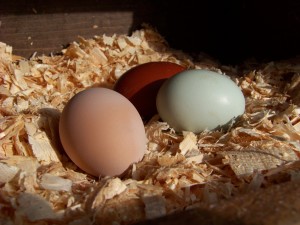 The chicken, of all the farm animals, has made our lives pretty easy as far as egg collection is concerned. Simply provide them a box, and they will deposit a neatly packaged protein source available for easy retrieval. It’s like a mailbox for breakfast.
The chicken, of all the farm animals, has made our lives pretty easy as far as egg collection is concerned. Simply provide them a box, and they will deposit a neatly packaged protein source available for easy retrieval. It’s like a mailbox for breakfast.
But being that the nesting box is what holds our “food item” until we come in with our egg basket to collect, I feel like the boxes should be the cleanest part of our coop. Because of this, I have very strict criteria for what makes a good nesting box. The box design plays a large role in keeping eggs clean and healthy.
If you’re in the market for a nesting box, whether you’re looking to purchase one already made, or plan on designing one yourself, be sure that the box fits these 5 criteria.
Easy to Clean
Nesting boxes need to be super easy to clean. If they’re not easy, because of human nature, it tends to become a dreaded chore and not done as often as it needs to be, then eggs get dirty, the boxes get gross and chicken keeping isn’t as fun as it could be.
The boxes shouldn’t be kept clean only to keep our breakfast clean, but to encourage our chickens to use the nesting boxes. They will turn their nose up at a filthy box and start laying eggs elsewhere. Like on the floor or in a corner where the eggs can be easily broken.
Clean boxes are also healthier for your chickens. They harbor less pest like bacteria and parasites that can make your chickens sick.
Non-Porous Building Material Like Plastic or Metal
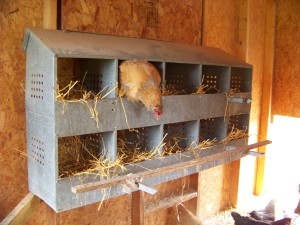 We’ve had our fair share of homemade wooden nest boxes. And the nice thing is that they can usually be made with scrap material, costing little to no money. It’s also simple enough to make a nest box if you can use a saw and a drill, you can make a nesting box.
We’ve had our fair share of homemade wooden nest boxes. And the nice thing is that they can usually be made with scrap material, costing little to no money. It’s also simple enough to make a nest box if you can use a saw and a drill, you can make a nesting box.
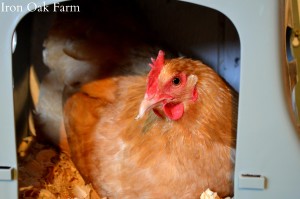 The problem I’ve found with wooden nesting boxes is that they’re difficult to keep clean, and to clean thoroughly. The porous wood gives little pests like bacteria, and parasites lots of nooks and crannies to borough. They also hold moisture in the form of wet dropping residue, old broken eggs and lots of other pleasantries. I recommend if you do choose to use wooden nesting boxes, to paint them to seal them and make them easier to clean.
The problem I’ve found with wooden nesting boxes is that they’re difficult to keep clean, and to clean thoroughly. The porous wood gives little pests like bacteria, and parasites lots of nooks and crannies to borough. They also hold moisture in the form of wet dropping residue, old broken eggs and lots of other pleasantries. I recommend if you do choose to use wooden nesting boxes, to paint them to seal them and make them easier to clean.
I prefer metal or plastic boxes because you can scrub them to their original state of cleanliness.
Size
A good size for a nesting box is around 14” x 14” x 14”. If you keep larger chickens like Jersey Giants you could go up with this number, likewise, bantam boxes can be smaller. You want them to feel as though they are enveloped in the space without having to squeeze in.
How high up off the floor?
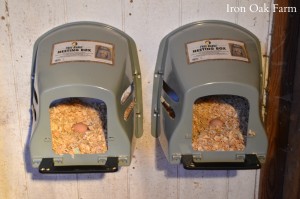
Boxes mounted off the ground tend to keep cleaner. We mount ours anywhere from 2 -4 feet off the ground. This makes for easy egg collection. If you keep breeds that don’t fly well, like Silkies, make sure that you mount them low enough so that the poor flyers can reach the boxes, or build a ramp up to the box height.
Bedding
 Clean bedding is the key to clean boxes. The box must allow a deep enough bedding layer (usually controlled by some sort of rim on the front of the box) so that the eggs don’t break when laid, or if they’re jostled around by other chickens using the same box.
Clean bedding is the key to clean boxes. The box must allow a deep enough bedding layer (usually controlled by some sort of rim on the front of the box) so that the eggs don’t break when laid, or if they’re jostled around by other chickens using the same box.
Bedding also helps prevent egg eating. If the chickens accidentally break an egg, the instinct is to eat the egg to “hide the evidence” from potential predators. The problem is that once chickens learn how delicious their own eggs are, they will then break the eggs on purpose. This behavior is hard to stop once it starts. And you will find yourself with an empty egg basket.
I prefer pine chips because of the pleasant pine aroma, but straw will also work.
How many nesting boxes per chicken?
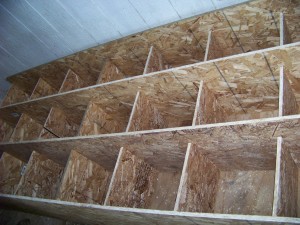
We once made a nest box for every one of our 30 chickens…it was a BIG mistake!
You need about 1 nesting box per 5 hens. Less than this and you might get some territorial issues.
If you have more than this, the chickens will more than likely start using the boxes to roost and sleep in. If this happens, the boxes get dirty very quickly because chickens poop where they sleep.
Discourage Roosting
 A good nesting box discourages roosting both inside and out. The problem with many homemade nest boxes is that they have a flat top/roof. To a chicken, this presents a nice area to sleep on. After a few nights, the top of your nesting boxes will be disgusting.
A good nesting box discourages roosting both inside and out. The problem with many homemade nest boxes is that they have a flat top/roof. To a chicken, this presents a nice area to sleep on. After a few nights, the top of your nesting boxes will be disgusting.
To discourage top roosting, the roof of your box should be slanted at a steep incline, or made from a slippery material like plastic.
Inside roosting is another problem where the chickens decide to sleep inside the nesting boxes. To prevent this, don’t offer too many boxes, (as mentioned above) but I’ve also found that any sort of partial, frontal closure helps discourage this behavior, whether it’s curtains or some sort of structural design to make the box more “cave-like”.
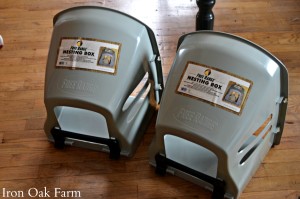 Recently I was at our Family Farm and Home store and I saw these plastic nesting boxes by Free Range. They passed all of my “Good Nesting Box” requirements and are very reasonably priced.
Recently I was at our Family Farm and Home store and I saw these plastic nesting boxes by Free Range. They passed all of my “Good Nesting Box” requirements and are very reasonably priced.
They are easy to install, really easy to clean and can be cleaned thoroughly because they are made of rounded plastic. The plastic also prevents parasites from borrowing in the material. It has a sloped roof to prevent roosting on the top and the front of the box turns toward the entrance to discourage inside roosting. I LOVE these boxes!
To learn more about the Free Range Nesting Boxes click the video.













17 Comments
Can I use plastic cookie box in making a nestbox for my lovebirds?
I drew a big hole for them to come in and small ones on the side.
The box’s size is like the size of a laptop.
Is that okay for them to breed?
I am considering using a plastic dog house that we have for our nesting box. It has a deep floor to hold the nesting material. We just started with two chicks that are now 8 weeks old. They do go roost in the dog house at night and seem to love it in there. The roof is a barn style and they can not roost on it without sliding off so they learned that quick. Is it OK to continue to use the dog house for their nesting box? We are planning on getting a couple more chicks in the future and I believe this dog house is plenty big enough for several but I don’t know if it is considered too big. It is meant for a medium to large dog. We have three of
these houses and our German Shepherd uses one. Any advice will be appreciated.
Can you share dimensions of the dog house? First reaction: the dog house should be a good home for your two chickens. A general rule of thumb is to have 2-3 square feet per chicken in their coop and 4-6 square feet in their run. For more chickens, you’ll probably need to consider if they all have enough roosting space, and how easy it is to clean the dog house of increased chicken poop. Glad you’ve found a fun solution for your current chickens!!!
Looking at these nesting boxes, how might it work to adapt a lidded cat litter box into a nesting box? Our town is pondering the keeping of chickens within the city – and I’m making plans!
What should I feed my chicks when I get them in the mail?
The poly nesting boxes I have are made in USA by Miller Manufacturing.
I think the web site is http://www.miller-mfg.com, or google them if I have it wrong. They are a good product. & the birds love them.
I really enjoyed all the information you all have wrote about. This is my 3 rd batch of chickens. Got fancy chickens and laying hens and more roosters than I need . My big problems the neighbors dogs, and I bought these chickens for 2 great grand kids girl and boy. Ive been in farming all my life but it was cattle. These chickens are a Hoot and I enjoy watching chickens and the kids, Now Im looking for a Little Mama Bantam with gold tiped wings or Id take white tiped. Please help if possible. have a Blessed Day, Charlene Swaims.
The link to the giveaway doesn’t work–I get the following message:
Page not found
Error 404
Sorry, the page you were looking for at this URL was not found.
sounds useful and I like easy to clean.
These are THE best nesting boxes I’ve used! They are so easy to install, just lift them off the wall, empty the old litter out, wash them out, allow to dry & hang them back up with litter & you’re done. The chickens love them too. I highly recommend them!!
We use the buckets that cat litter comes in for our nesting boxes. The right size and easy to keep clean. We do put a piece of board across the bottom edge to keep the hens from kicking the nesting material and eggs out of the box. It can easily be replaced regularly to keep it clean and pest free.
Is there a website that sells these nesting boxes. There is none of the stores listed above around where I live. I would love to find a website that I could order them from. Thank you for your help
Hi Lisa! If there’s an Ace Hardware, Bomgaars, Murdocks, Tractor Supply close to you I think that they all carry them. I will look on one of mine to see if the manufacturer has a web site listed & leave you another reply. They run anywhere from $19.95 to $24.00. I’m in Colorado so I hope this helps you in some way.
Don’t forget the wonders of the rollaway nest! The eggs are amazingly clean and so easy to collect. If I had more chickens than our modest 15, I would definitely be looking into one of these, offered by a nearby family farm. I’ve seen them at work and they’re wonderful!
http://bestnestbox.com/
These look great. We’re getting chicks in the Spring so are busy planning our coop!
I have the 10-hole metal box like you have in the first photo. I got it for $20 at a yard sale. It really works well for our 14 laying hens, but, as you mentioned, a couple of our youngsters, when first added to the coop, thought that the nest box was a really cozy place to sleep. I had to take them out and put them on our roosting ladders for a few weeks before they got the hang of it. According to your calculations, we have too many openings, but we can always get more hens to make up the difference!
We use old milk crates for nesting boxes, they are easy to clean and move and the hens love them.